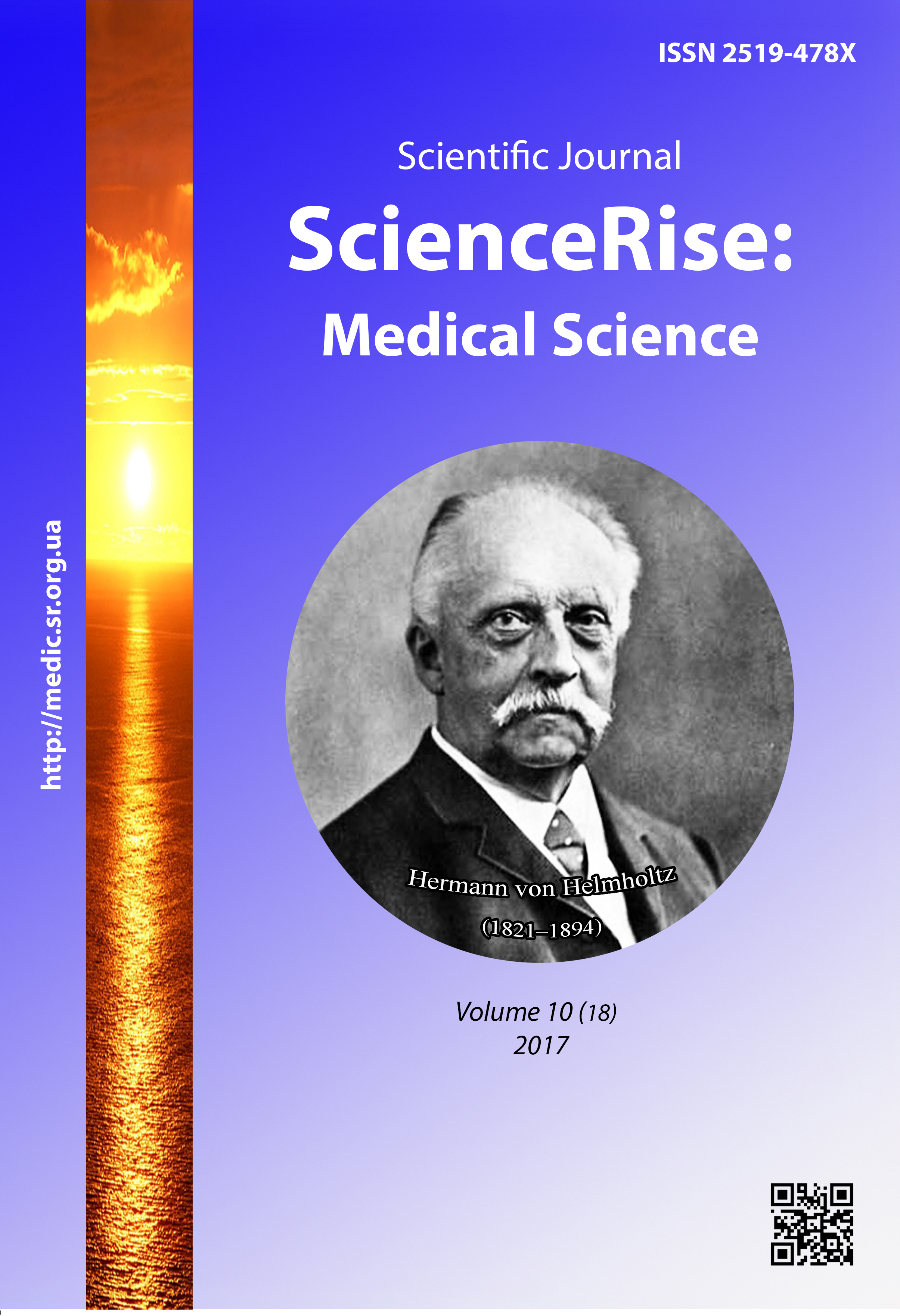Analysis of complications that occurred in the perioperative period, when using different modes of fluid therapy
DOI:
https://doi.org/10.15587/2519-4798.2017.113527Keywords:
restrictive fluid resuscitation, purposeful fluid therapy, hemodynamics, vasopressors, hypovolemia, organ perfusionAbstract
Aim: To realize the clinical analysis of post-surgical complications in patients, who received intraoperative infuse therapy by the method of the restrictive mode of fluid resuscitation and purposeful fluid therapy for providing the adequate and stable hemodynamics in perioperative period and also for preventing the complications development.
Materials and methods: the study was realized in 176 patients, who underwent surgical interventions in orthopedic oncology. The restrictive mode of fluid resuscitation was applied in 88 cases, and in 88 ones – the purposeful fluid therapy. The central hemodynamics was studied by the method of Cubichek tetrapolar rheography, coagulogram indications, dieresis speed, blood serum creatinine, frequency of postoperative nausea and vomit and enteroparesis were studied.
Research results: the frequency of coagulopathy observations at purposeful fluid therapy didn’t reliably exceed the frequency of coagulopathy in patients with the restrictive mode. Patients, who underwent purposeful fluid therapy demonstrated the decrease of dieresis speed, postoperative nausea and vomit and enteroparesis reliably more seldom. At providing purposeful fluid therapy, there was observed the more stable hemodynamics, whereas patients with the restrictive mode of resuscitation reliably more often needed for the additional hemodynamic correction, which needed the use of vasopressors in 67 % of cases and unplanned increase of infusion therapy volume in 36 % of cases.
Conclusions: the risk of complications of GIT and kidneys decreases at using purposeful fluid therapy, and the more stable postoperative hemodynamics comparing with the restrictive mode is guaranteed
References
- Butler, F. K., Holcomb, J. B., Schreiber, M. A. et. al. (2015). Liquid resuscitation in case of hemorrhagic shock in the Manual for first aid in combat conditions by unqualified personnel. Medicine of non-adherence to the countries, 3, 56–83.
- Dutton, R. P. (2014). Management of traumatic haemorrhage – the US perspective. Anaesthesia, 70, 108–e38. doi: 10.1111/anae.12894
- Gutierrez, M. C., Moore, P. G., Liu, H. (2013). Goal-Directed Therapy in Intraoperative Fluidand Hemodynamic Management. Journal of Biomedical Research, 27 (5), 357–365. doi: 10.7555/JBR.27.20120128
- Cata, J. P., Gottumukkala, V. (2012). Blood Loss and Massive Transfusion in Patients Undergoing Major Oncological Surgery: What Do We Know? ISRN Anesthesiology, 2012, 1–11. doi: 10.5402/2012/918938
- Veelo, D. P., van Berge Henegouwen, M. I., Ouwehand, K. S., Geerts, B. F., Anderegg, M. C. J., van Dieren, S. et. al. (2017). Effect of goal-directed therapy on outcome after esophageal surgery: A quality improvement study. PLOS ONE, 12 (3), e0172806. doi: 10.1371/journal.pone.0172806
- Voldby, A. W., Brandstrup, B. (2016). Fluid therapy in the perioperative setting–a clinical review. Journal of Intensive Care, 4 (1), 27. doi: 10.1186/s40560-016-0154-3
- Pang, Q., Liu, H., Chen, B., Jiang, Y. (2017). Restrictive and liberal fluid administration in major abdominal surgery. Saudi Medical Journal, 38 (2), 123–131. doi: 10.15537/smj.2017.2.15077
- Kaur, M., Anjum, A., Soni, K., Kumar, A., Albert, V., Sawhney, C., Subramanian, A. (2013). Assessment of hemostatic changes after crystalloid and colloid fluid preloading in trauma patients using standard coagulation parameters and thromboelastography. Saudi Journal of Anaesthesia, 7 (1), 48–56. doi: 10.4103/1658-354x.109809
- Doherty, M., Buggy, D. J. (2012). Intraoperative fluids: how much is too much? British Journal of Anaesthesia, 109 (1), 69–79. doi: 10.1093/bja/aes171
- Kozek-Langenecker, S. A., Afshari, A., Albaladejo, P., Santullano, C. A. A., De Robertis, E., Filipescu, D. C. et. al. (2013). Management of Severe Perioperative Bleeding: Guidelines from the European Society of Anaesthesiology. European Journal of Anaesthesiology, 30 (6), 270–382. doi: 10.1097/eja.0b013e32835f4d5b
- Rossaint, R., Bouillon, B., Cerny, V., Coats, T. J., Duranteau, J., Fernandez-Mondejar, E. et. al. (2016). The European guideline on management of major bleeding and coagulopathy following trauma: fourth edition. Critical Care, 20 (1), 100. doi: 10.1186/s13054-016-1265-x
Downloads
Published
How to Cite
Issue
Section
License
Copyright (c) 2017 Mykola Lyzohub, Sergii Kursov, Kseniia Lyzohub

This work is licensed under a Creative Commons Attribution 4.0 International License.
Our journal abides by the Creative Commons CC BY copyright rights and permissions for open access journals.
Authors, who are published in this journal, agree to the following conditions:
1. The authors reserve the right to authorship of the work and pass the first publication right of this work to the journal under the terms of a Creative Commons CC BY, which allows others to freely distribute the published research with the obligatory reference to the authors of the original work and the first publication of the work in this journal.
2. The authors have the right to conclude separate supplement agreements that relate to non-exclusive work distribution in the form in which it has been published by the journal (for example, to upload the work to the online storage of the journal or publish it as part of a monograph), provided that the reference to the first publication of the work in this journal is included.









